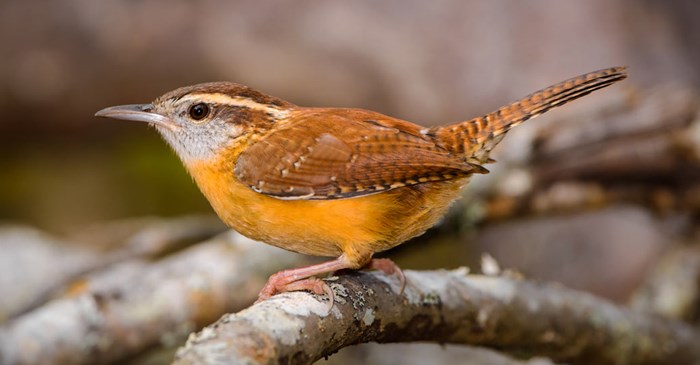The Carolina Wren is a cinnamon brown bird with white eyebrows and a buff colored chest and belly, and the upturned tail that is characteristic of wrens. These cute birds with the distinctive song can be found throughout much of the eastern half of the U.S. (with the exception of the northernmost states).
Nesting habits of the Carolina Wren
When a pair of Carolina Wrens nest in your backyard, their nesting and the courtship are like a children’s story brought to life. The Carolina Wren prefers nesting in old woodpecker holes and other cozy spots where they can safely hide away their eggs and nestlings. But they’ve been known to choose some adorable nooks and crannies, including abandoned flower pots, mailboxes or even a watering can.
As with other wren species, the male shops a selection of nesting sites to find his potential mate. He places sticks and grasses in each location, a bit like a Realtor staging a house with furniture to “sell” the site. If you discover a haphazard pile of twigs inside the nesting box you set up, it’s probably the work of a Carolina Wren trying to win over a mate.
The Carolina Wren mates for life, raising two to three broods in a season. If you’re lucky enough to see a nesting pair in your backyard, they’ll stick around after the final brood grows up and leaves, where they’ll maintain their territory.
The song of the Carolina Wren
If you’re on the search for a Carolina Wren, sound is the best method. Their brown plumage keeps them well camouflaged as they forage in the trees and brush for food. Their piercing songs sound like Teakettle! Teakettle!, which can be heard ringing through the forests and other richly vegetated areas.
Carolina Wren in your backyard
The Carolina Wren prefers insects and bugs, but when the temperatures cool off for the fall and winter, they’ll switch to the withered berries still clinging to trees and shrubs, along with select seeds.
Filling your feeder with Lyric Fine Tunes No Waste Mix is a good strategy to draw in a pair of Carolina Wrens. The sunflower kernels, pistachios and almonds in this handcrafted blend are finely cut to accommodate smaller beaks.
